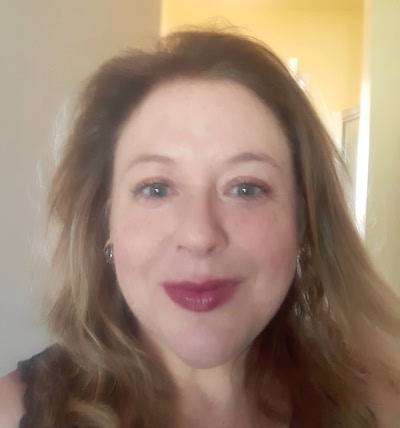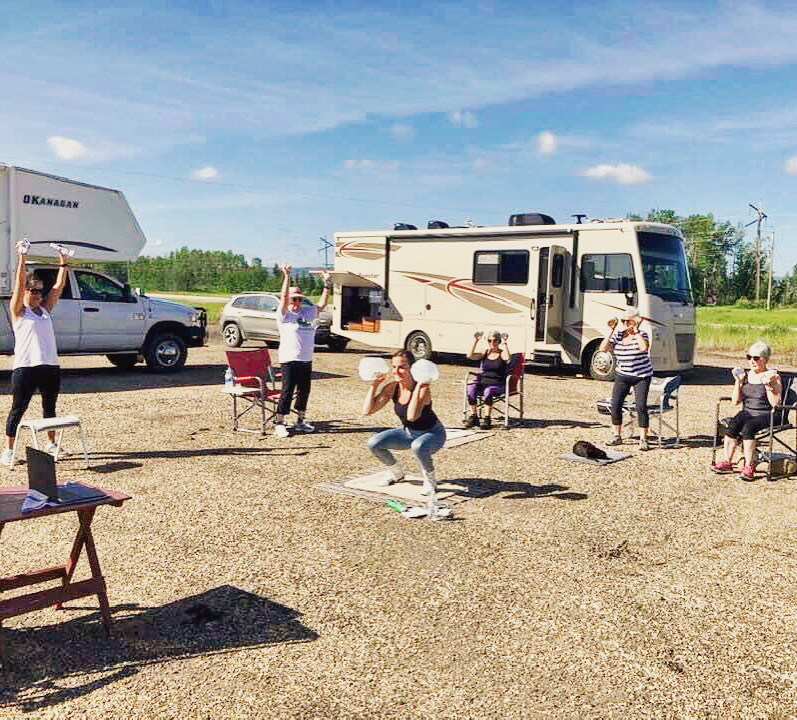
- Details
- By Tamara Ikenberg
CRYSTAL FALLS, Mich. — Gathering her fringed fancy dance shawl around her, Ojibwe fitness instructor Michelle Reed gracefully tiptoes while showing her sneak-up, a powwow dance that simulates taking your enemies by surprise.
“We’re working those calves, sneaking it up,” said Reed, while leading dozens of students during a recent installment of her online N8V Dance Fitness class, which she broadcasts Monday through Friday at 6 p.m. from her home art studio in Crystal Falls, Mich.
“I try to set my fitness class up like what you’re used to seeing at a traditional powwow. Then they’ll know the rundown of the powwow,” Reed said. She is very conscientious about presenting the correct cultural information. “I posted the history behind the sneak-up on my Facebook page.”
Reed has built a committed following who join in for the cardio and culture.
When it comes to keeping fit at home on the Menominee Indian Reservation in Keshena, Wis., Connie Rasmussen clears her 6 p.m. every weeknight to dance with Reed. “I have plenty of other videos and workout things on DVD and I don't even watch them. They’re boring,” Rasmussen said. “But with Michelle, and the music, drumming and singing, I enjoy it. I don't really think of it as a workout. It’s just a fun time.” Rasmussen said that when her grandchildren visit, they also join in on the workouts.
Rasmussen and other Native Americans looking out for their health while staying inside due to the pandemic are tuning in to a growing group of Indigenous fitness instructors offering free online workouts that are also often exercises in culture.
“There are thousands and thousands of workouts on this planet that people can do, but there are very few Native workouts by Native people,” said Reed, who moved her N8V Dance fitness classes online shortly after the pandemic began. “People need something right now, and when you can exercise and have that cultural part in it as well. It's a two-birds-with-one-stone kind of thing right there.”
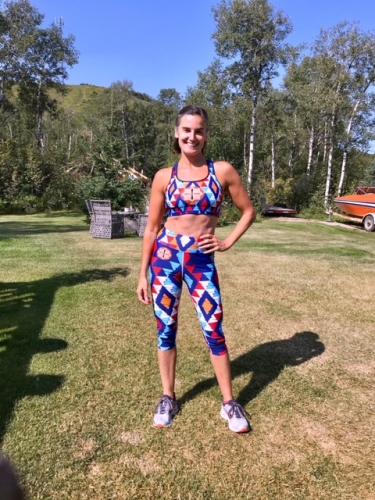 Fit Native TV trainer Tanis Parenteau (Métis) usually broadcasts her online fitness classes from the backyard of her parents' home in Alberta. (Tanis Parenteau)The Indigenous exercise scene stars some personalities people may already be familiar with, like champion hoop dancer Dallas Arcand (Alexander First Nation) and personal trainer and “Billions” and “House of Cards” actress Tanis Parenteau (Métis), who teaches Fit Native TV for the American Indian Community House in New York City.
Fit Native TV trainer Tanis Parenteau (Métis) usually broadcasts her online fitness classes from the backyard of her parents' home in Alberta. (Tanis Parenteau)The Indigenous exercise scene stars some personalities people may already be familiar with, like champion hoop dancer Dallas Arcand (Alexander First Nation) and personal trainer and “Billions” and “House of Cards” actress Tanis Parenteau (Métis), who teaches Fit Native TV for the American Indian Community House in New York City.
Various Indian health organizations, including the Sonoma County Indian Health Project and the Minneapolis American Indian Center, also regularly post workouts on their Facebook pages, ranging from stretching and yoga classes to hoop fitness classes.
Popular Native Facebook groups that popped up during the pandemic, like Social Distance Powwow, and Quarantine Dance Specials 2020, also air some of the workouts, which provide a relatable and essential service for a population with high levels of diabetes, heart conditions and obesity.
“Although we’re not doing our powwows this summer, we have to keep moving,” Rasmussen said. “I'm 58 years old and I'm not getting any younger, so I want to keep mobile. I'm trying to prevent diabetes and high cholesterol because both of those run in my family.”
Reed originally developed her N8V Dance Fitness routines for Indigenous communities, and normally teaches it at her studio. She also travels the country sharing her fitness and art skills at universities and Native health organizations.
She keeps her students interested and in the powwow spirit by incorporating accessories like her own shawl, and the fringed, ribboned and feathered sticks used in men’s fancy dance.
“When you’re dancing and moving your arms, and you’re holding them they are like weights in your hands, and it adds to the workout, because you’re trying to get the frings to move back and forth,” she said. “It’s something to take your mind off the fact you're working out, and it’s also a way to make the boys feel more confident and comfortable and show them it’s not just for girls.”
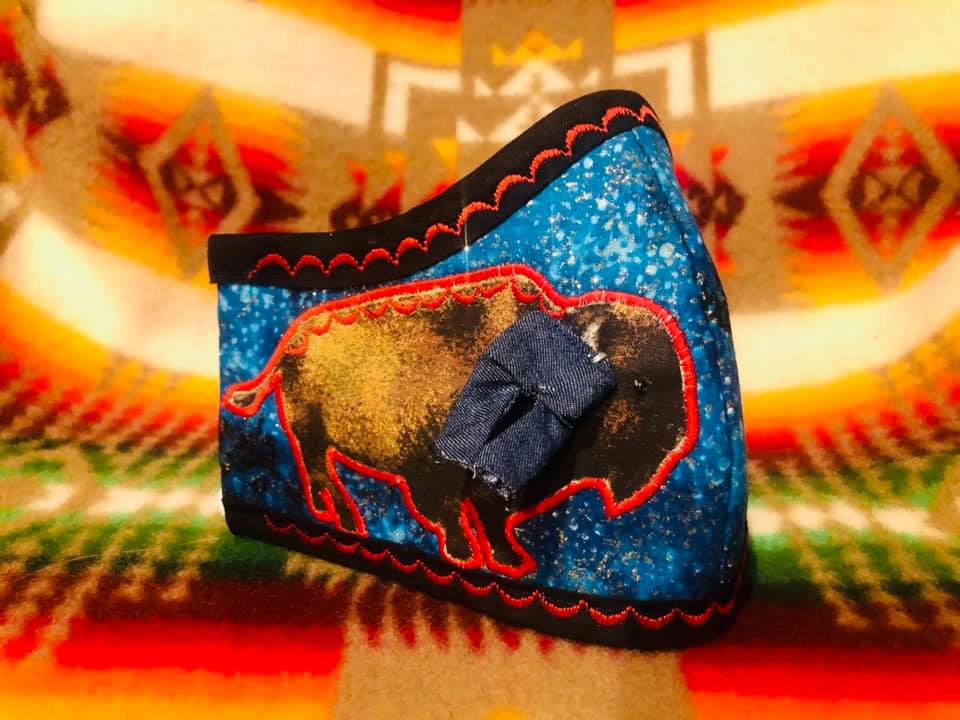 N8V Dance Fitness instructor Michelle Reed (Ojibwe) makes masks and other art treats to give away as prizes to her students. This one references a recent bison incident in South Dakota that went viral. (Michelle Reed)
N8V Dance Fitness instructor Michelle Reed (Ojibwe) makes masks and other art treats to give away as prizes to her students. This one references a recent bison incident in South Dakota that went viral. (Michelle Reed)
Her passion for Native artwork is also woven into the workouts, and Reed makes exercise even more enticing by entering everyone who tunes in into a weekly raffle where they can win an original art piece made by Reed, like a face mask or a pair of earrings.
“I won a beautiful mask with a striped Native pattern,” Rasmussen said. “Masks are really important now, so that was one of the incentives and I happened to win it and I didn’t even know I had won.”
Reed advises catching the workouts live if you can and treating it as if you were actually going to your gym or favorite workout studio for a scheduled class to get the maximum mental and emotional benefits, as well as a satisfying sweaty physical workout.
“People look forward to it, they plan for it. They’re excited about getting entered to win the prize,” she said. “It can be like night and day when you add something like this. Because not only are you moving, but you have that connection to other people. We are interacting, we’re helping each other. I have people commenting to other people during the workout. Otherwise I could just post one video and they could do it over and over. That’s not helping me. I’m doing it for me, too.”
Sweating with pride
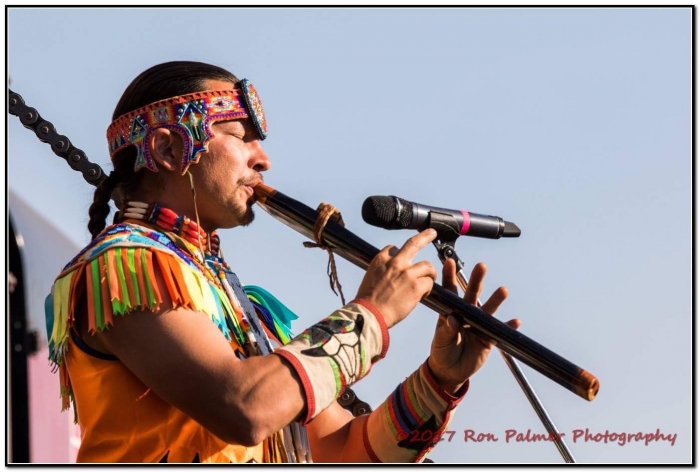 Powwow Dance Aerobics instructor Dallas Arcand is also a champion hoop dancer and Indian flute player. (Ron Palmer Photography)
Powwow Dance Aerobics instructor Dallas Arcand is also a champion hoop dancer and Indian flute player. (Ron Palmer Photography)
In the case of Dallas Arcand’s Powwow Dance Aerobics classes, the early bird gets the word.
The champion hoop dancer has been broadcasting from the Alexander First Nation in Alberta, Canada around 7 a.m. almost every morning for about five months.
“I do a Cree word of the day pretty much in every class. I have an assistant that writes Cree syllabic, Cree words and definitions,” said Arcand, who is currently shopping for a Powwow Dance Aerobics pilot for a morning TV series.
“I remember in the mornings there used to be workout shows, down in the states it would probably be Jane Fonda or Richard Simmons. I don't remember there ever being an Indigenous version of that. I just decided why don't I sort of do the Richard Simmons thing and the Jane Fonda thing, and Indigenize it and use it as a way to communicate culture, and share some language?” he said.
Lisa Urizandi (Ojibwe Wasauksing First Nation) meets Arcand virtually every morning.
“I always do the workouts when he is live. I feel more connected to him and others in the class, which motivates me more,” Urizandi said. “He talks about Indigenous history and talks about the languages which gets me through the workouts easier. It gives me strength to hear about all of our people. His workouts have helped me not only in a physical sense by making me feel stronger cardio-wise but also in a spiritual way. He makes me feel more connected to my culture and proud to be Indigenous.”
Arcand’s workout is a high-energy conditioning class with some dance moves and hoop action occasionally mixed in. Each workout has a theme like, “Life is what you make it” or “Letting things go and letting things flow.”
“I've done this routine for years to keep myself in shape. I've done it privately, I've never really televised it or publicized my workouts,” Arcand said. “I figured that it'd be a good time to do that since a lot of people are in self-isolation. I really enjoy it, because as an artist, I've been always trying to find new ways to connect with my audience.”
Arcand teaches from a holistic perspective. His workouts blend mental, emotional, physical and spiritual health, and he sometimes uses his other talents to take his students to a peaceful place that prepares them for the best workout possible.
“Every once in a while I'll bust out the Indian flute and use it as a form of meditation,” he said.
Beginning the class in a zen, meditative state also allows his students to more fully absorb Arcand’s teachings.
“A lot of people don't know their own history of how things got to where they are today, and that's one of the things I talk about in my class,” he said. “I talk about how Indigenous people have diabetes now when there wasn't such a thing years and years and years and generations ago. Our people lived off the land, and once they were infiltrated by Europeans, it changed their ways forever.”
In Arcand’s classes, there is always something to learn, even if a participant can’t physically keep up with him the whole time.
“I definitely encourage people to try it and to take it on, and just do it at their own comfort level where they're safe and they're comfortable. I'll do a warm up, then I'll do the meditation and stretching part, and then I'll do a couple more songs, and I'll say, ‘You know what, you only need 20 minutes a day and it does so much.’ It's like my life coach says, ‘Any imperfect action is better than taking no action.’”
Make it work for you
Injuries and pre-existing conditions don’t have to get in the way of a good workout. Reed suggests and demonstrates modifications, and Rasmussen has found ways to work around her own physical limitations.
“I do have a degenerative disc disease in my back so I can't always do some of the things Michelle does, like the full dancing and the bouncing,” Rasmussen said. “I just go gentle.”
When Reed devotee Elizabeth Lewis is faced with a challenging balance exercise during class, the 70-year-old Woodlands, Texas resident reaches out to furniture for support.
“When I need to hold on to something I have a high table in the living room that we've been using to do puzzles during the pandemic,” Lewis said.
Tuning in to N8V Dance Fitness is helping Lewis deal with some of the issues caused by a lifelong lymphatic condition that causes major swelling in her legs. “I’m getting a better range of motion and some strength. It’s helping me to get better leg muscles and better leg circulation.”
Rest and modifications are key to Tanis Parenteau’s Fit Native TV workouts, which she teaches for the nonprofit American Indian Community House in New York City.
The twice-weekly workouts on Tuesday and Thursday were developed expressly for folks looking to stay fit during this time of social distancing, and are available on the AICH Facebook page, Parenteau’s Facebook page and on YouTube.
Parenteau describes her class as a “circuit-style strengthening and conditioning workout, with self-regulated rest periods,” meaning rest is built into the workouts, and participants can pause whenever their bodies need a break. Lunges, push-ups, squats and crunches are among Parenteau’s moves.
“This is the opposite of a class where they tell you when to rest and you have to go when they say ‘go’ and you have to stop when they say ‘stop,’” Parenteau said. “It's more optimal that way because you can’t be pushing someone if they can’t go anymore. Then you’re prone to injury and many things can go wrong.”
Matinecock and Wamponoag student Tecumseh Ceaser does Parenteau’s workouts live at least once a week.
“I like that Tanis does a lot of modifications. It has helped me because I have an old wrist injury and her modifications allow me to not feel discouraged when it flares up,” Ceaser said. “I do a lot of walking, but her class helps me do toning. Between walking and her classes, I've lost 20 pounds since March.”
Parenteau, who lives in New York but is currently at her parents’ home in Alberta, where she primarily broadcasts from the backyard, always has a chair on set to demonstrate alternative, less strenuous ways of performing exercises.
In one of her videos, titled “The Aunties Campground Workout,” her own relatives model the modifications.
“A bunch of my extended family went camping further north in Alberta and we stayed in a gravel pit with all our motorhomes. And I had to do my workout so I did it in the gravel pit,” she said. “There are three aunties and my mom behind me and they did the workout with me, and it was great because I usually do the modifications for Elders myself, but that way they could do them.”
Parenteau is also a paragon of fitness resourcefulness. She is skilled at substituting random household items for dumbbells, and encourages her students to do the same.
“That started because in my apartment I have two fabulous gyms that ended up getting closed down, and I had to workout in my apartment and I don’t have dumbbells. I don’t need them because they’re in my gym, so I just started using whatever I had, which were detergent jugs, a backpack full of cat litter, or books,” she said. “When I came to Alberta, I used whatever we had. There were bricks lying around outside so I used some bricks. Now I found some oil jugs and they have these handles on the sides so they’re a little more ergonomic for me. You can even use soup cans. Use whatever you got.”
Having a bunch of specialized equipment and performing the workouts perfectly isn’t the aim. Staying active and being consistent are the real goals.
“The American Indian Community House is based in New York City and a lot of Elders are in their apartments and they can’t go anywhere because they’re more susceptible to COVID-19,” Parenteau said. “It's important to be able to have a link to use your body and exercise as much as you can to the best of your ability.”
Parenteau understands that sometimes finding the motivation to move your body can be the biggest obstacle of all.
“If you don't feel like doing anything or working out, lower your barrier of entry. Have a talk with yourself and say ‘I'm going to put my shoes on and I'm just going to go outside, or, while I boil my water for my tea, I’ll do one squat,’” Parenteau said. “Do that thing, high-five yourself, pat yourself on the back, and say I did that thing. Celebrate those small little successes, which will make you feel good and make you want to do more. Maybe you’ll workout for five minutes instead of 15, or 15 instead of 30. Don't be too hard on yourself.”
More Stories Like This
Seven Deaths in Indian Country Jails as Inmate Population Rises and Staffing DropsSen. Luján Convenes Experts to Develop Roadmap for Native Maternal Health Solutions
Senate Passes Bill Aimed at Missing and Murdered Indigenous Peoples Crisis
Johns Hopkins Collecting Tribal Success Stories from $1.5B Opioid Settlement
Arizona MMIP Task Force Holds Listening Session for Survivors and Families

